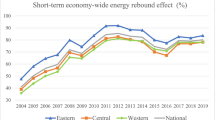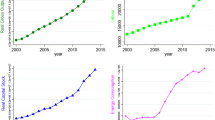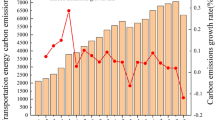Abstract
The energy consumption and CO2 emissions of the transportation sector in China have increased greatly in recent years, accompanied by the growing regional disparities. Considering undesirable output and environmental impact factors, a four-stage DEA (data envelope analysis) combined with NDDF model (non-radical directional distance function) is adopted in this paper to calculate the energy efficiency and eliminate the environmental impacts of Chinese transportation sector. In this paper, five environmental factors are considered, including GDP per capita, consumption level, urbanization level, economic openness level, and transport infrastructure. The empirical results on the panel data for 30 provinces of China from 2005 to 2016 show that the energy efficiency of the transportation sector in China decreases from Eastern to Western region. After the adjustment of environmental factors, energy efficiency still shows a decreasing trend from Eastern to Western region, while energy efficiency increases more in Eastern region and less in Central region and Western region. The potential of energy efficiency improvement for some Central and Western provinces is relatively high. Some policy suggestions are proposed to improve the energy efficiency of Chinese transportation sector.



Similar content being viewed by others
References
Clinch, J. P., Healy, J. D., & King, C. (2001). Modelling improvements in domestic energy efficiency. Environmental Modelling and Software, 16(1), 87–106.
Cui, Q., & Li, Y. (2014). The evaluation of transportation energy efficiency: an application of three-stage virtual frontier DEA. Transportation Research Part D: Transport and Environment, 29, 1–11.
Fang, C. Y., Hu, J. L., & Lou, T. K. (2013). Environment-adjusted total-factor energy efficiency of Taiwan’s service sectors. Energy Policy, 63, 1160–1168.
Feng, C., & Wang, M. (2018). Analysis of energy efficiency in China’s transportation sector. Renewable and Sustainable Energy Reviews, 94(6), 565–575.
Fried, H. O., Schmidt, S. S., & Yaisawarng, S. (1999). Incorporating the operating environment into a nonparametric measure of technical efficiency. Journal of Productivity Analysis, 12(3), 249–267.
Hsu, F. M., & Hsueh, C. C. (2009). Measuring relative efficiency of government-sponsored R&D projects: a three-stage approach. Evaluation and Program Planning, 32(2), 178–186.
Hu, J. L., & Kao, C. H. (2007). Efficient energy-saving targets for APEC economies. Energy Policy, 35(1), 373–382.
Ji, X., & Chen, G. Q. (2006). Exergy analysis of energy utilization in the transportation sector in China. Energy Policy, 34(14), 1709–1719.
Li, L.-b., & Hu, J.-l. (2011). Efficiency and productivity of the Chinese railway system: application of a multi-stage framework. African Journal of Business Management, 22(5), 8789–8803.
Li, H., Fang, K., Yang, W., Wang, D., & Hong, X. (2013). Regional environmental efficiency evaluation in China: analysis based on the super-SBM model with undesirable outputs. Mathematical and Computer Modelling, 58(5–6), 1018–1031.
Lin, B., & Zhang, G. (2017). Energy efficiency of Chinese service sector and its regional differences. Journal of Cleaner Production, 168, 614–625.
Lipscy, P. Y., & Schipper, L. (2013). Energy efficiency in the Japanese transport sector. Energy Policy, 56, 248–258.
Liu, H., & Lin, B. (2017). Energy substitution, efficiency, and the effects of carbon taxation: evidence from China’s building construction industry. Journal of Cleaner Production, 141, 1134–1144.
Liu, H., Yang, Z., Zhu, Q., & Chu, J. (2017). Environmental efficiency of land transportation in China: a parallel slack-based measure for regional and temporal analysis. Journal of Cleaner Production, 142, 867–876.
Song, X., Hao, Y., & Zhu, X. (2015). Analysis of the environmental efficiency of the Chinese transportation sector using an undesirable output slacks-based measure data envelopment analysis model. Sustainability, 7, 9187–9206.
Song, M., Zheng, W., & Wang, Z. (2016a). Environmental efficiency and energy consumption of highway transportation systems in China. International Journal of Production Economics, 181, 441–449.
Song, M., Zhang, G., Zeng, W., Liu, J., & Fang, K. (2016b). Railway transportation and environmental efficiency in China. Transportation Research Part D: Transport and Environment, 48(12), 488–498.
Tone, K. (2002). Continuous optimization a slacks-based measure of super-efficiency in data envelopment analysis. European Journal of Operational Research, 143, 32–41.
Tongzon, J. (2001). Efficiency measurement of selected Australian and other international ports using data envelopment analysis. Transportation Research Part A: Policy and Practice, 35(2), 107–122.
Tsai, P. F., & Molinero, C. M. (2002). A variable returns to scale data envelopment analysis model for the joint determination of efficiencies with an example of the UK health service. European Journal of Operational Research, 141(1), 21–38.
Vanek, F. M., & Morlok, E. K. (2000). Improving the energy efficiency of freight in the United States through commodity-based analysis: justification and implementation. Transportation Research Part D: Transport and Environment, 5(1), 11–29.
Vlontzos, G., Niavis, S., & Manos, B. (2014). A DEA approach for estimating the agricultural energy and environmental efficiency of EU countries. Renewable and Sustainable Energy Reviews, 40, 91–96.
Wang, Z., & He, W. (2017). CO2 emissions efficiency and marginal abatement costs of the regional transportation sectors in China. Transportation Research Part D: Transport and Environment, 50, 83–97.
Wang, K., Huang, W., Wu, J., & Liu, Y. N. (2014). Efficiency measures of the Chinese commercial banking system using an additive two-stage DEA. Omega, 44, 5–20.
Wu, J., Lin, L., Sun, J., & Ji, X. (2015). A comprehensive analysis of China’s regional energy saving and emission reduction efficiency: from production and treatment perspectives. Energy Policy, 84, 166–176.
Yang, T., Chen, W., Zhou, K., & Ren, M. (2018). Regional energy efficiency evaluation in China: a super efficiency slack-based measure model with undesirable outputs. Journal of Cleaner Production, 198, 859–866.
Zhang, N., & Wei, X. (2015). Dynamic total factor carbon emissions performance changes in the Chinese transportation industry. Applied Energy, 146, 409–420.
Zhang, J., Hui, L. , Bo, X., & Martin. S. (2018). Impact of environment regulation on the efficiency of regional construction industry: A 3-stage Data Envelopment Analysis (DEA). Journal of Cleaner Production, 200, 770–780.
Zhou, P., Ang, B. W., & Wang, H. (2012). Energy and CO2 emission performance in electricity generation: a non-radial directional distance function approach. European Journal of Operational Research, 221, 625–635.
Zhou, G., Chung, W., & Zhang, Y. (2014). Measuring energy efficiency performance of China’s transport sector: a data envelopment analysis approach. Expert Systems with Applications, 41(2), 709–722.
Funding
This work was supported by National Natural Science Foundation of China (No. 71673250), Zhejiang Foundation for Distinguished Young Scholars (LR18G030003), Major Projects of the Key Research Base of Humanities Under the Ministry of Education (No.14JJD 790019), and Academy of Financial Research, Zhejiang University.
Author information
Authors and Affiliations
Corresponding author
Ethics declarations
Conflict of interest
The authors declare that they have no conflict of interest.
Additional information
Publisher’s note
Springer Nature remains neutral with regard to jurisdictional claims in published maps and institutional affiliations.
Rights and permissions
About this article
Cite this article
Chen, Y., Cheng, S. & Zhu, Z. Measuring environmental-adjusted dynamic energy efficiency of China’s transportation sector: a four-stage NDDF-DEA approach. Energy Efficiency 14, 35 (2021). https://doi.org/10.1007/s12053-021-09940-5
Received:
Accepted:
Published:
DOI: https://doi.org/10.1007/s12053-021-09940-5




